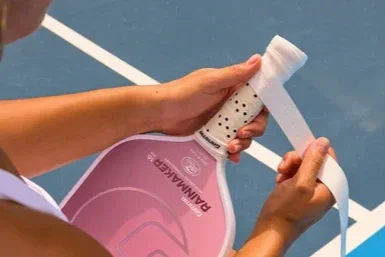Pickleball Grip Size: The Key to Protecting Your Elbow
You’ve probably heard people say, “Just grip it tight and swing.” That’s lazy advice. Grip size is one of those invisible details that can quietly wreck your wrist, elbow, or shoulder over time—especially in pickleball, where the ball is lighter but your reactions are fast and repetitive.
No matter your level, grip fit matters. “Pickleball elbow,” wrist strain, and joint flare-ups often trace back to the wrong grip. Sports medicine experts now call overuse injuries the top issue in pickleball, and upper extremity pain—wrist, elbow, shoulder—accounts for a big chunk of them.
Bottom line: Your grip is your foundation. Get it wrong, and the foundation cracks.
Why Grip Size Matters
Your paddle is an extension of your arm. When the handle doesn’t fit your hand, your muscles and tendons have to work overtime. That’s when the pain creeps in.
When Your Grip Is Too Small:
You squeeze harder—especially on fast exchanges.
The tension overloads your forearm muscles and tendons (hello tennis elbow).
Wrist stabilizers fatigue faster, and your overall control drops.
When Your Grip Is Too Big:
Your wrist loses mobility and finesse.
Stress shifts to your elbow and shoulder.
Shots feel clunky instead of clean.
Even experienced players sometimes blame their paddle when the real issue is grip size.
How to Measure Your Pickleball Grip Size
No guesswork—just two easy tests.
Method A: The Ruler Test
Open your dominant hand, fingers extended.
Measure from the middle crease of your palm (when your hand bends) to the tip of your ring finger.
That number (in inches) is your approximate grip circumference.
Method B: The Finger Test (Real-World Check)
Hold a paddle (or mock handle) normally.
Try fitting your non-dominant index finger between your ring finger and your palm.
If it fits snugly (just a little space), you’re good. Too tight? Grip’s too small. Too roomy? Grip’s too big.
General Sizing Guide:
Use your height as a general guide to help you find your grip size.
Under 5’2 → 4 ⅛” grip
5’3”-5’8” → 4 ⅜” grip
5’9” and up → 4 ½”-4 ¾” grip
Most paddle grips range from 4.0 to 5.0 inches, though many stay under 4.75.”
Remember: grips compress with use. If your paddle feels smaller than it used to, it probably is.
How the Wrong Grip Impacts Your Joints
Here’s what’s happening under the skin when your grip isn’t right:
Tennis / Pickleball Elbow (Lateral Epicondylitis): outer elbow tendons inflame from over-gripping or poor paddle control.
Golfer’s Elbow (Medial Epicondylitis): same deal, but on the inner elbow.
Wrist Tendinitis: extra torque stresses stabilizing tendons.
Arthritis Flares: misfit grips accelerate wear on sensitive joints.
Shoulder Strain: when the wrist and elbow overwork, the shoulder compensates.
Early warning signs include dull ache, tightness, or reduced endurance. If you’re finishing matches with sore forearms or stiff elbows, check your grip before you blame your swing.
What to Do If You’re Using the Wrong Grip
Good news: this is fixable.
1. Add or Remove Layers
Need to increase size? Add an overgrip—each layer adds about 1/16 inch.
Need to decrease? Go to a thinner base grip (if possible).
Quick, cheap, and reversible.
2. Upgrade to a Cushioned or Ergonomic Grip
Some grips include shock absorption or molded shapes that reduce vibration and joint stress.
3. Lighten Your Paddle
Heavier paddles amplify strain. If your grip feels borderline, a lighter paddle helps reduce torque.
4. Adjust Technique
Grip looser. Use your body, not just your arm. Try wrist and forearm strengtheners (like the Tyler Twist) to build forearm strength and resistance to strain.
5. Rest and Recover
If pain’s creeping in, rest it. Ice, stretch, and ease back in. Persistent pain deserves a medical check—don’t push through it.
6. Reevaluate Regularly
Hands change—age, swelling, wear—even muscle gain can shift what feels right. Re-measure every few months.
Gear That Helps Protect Joints
If you’re looking to upgrade or adjust, here are a few solid options:
Overgrips: Tourna Grip, Gamma Supreme, Head Xtreme Soft—great for layering and absorbing sweat.
Replacement Grips: Hesacore, Selkirk Contour, Wilson Cushion-Air—add comfort and cushioning.
Ergonomic Options: ProXR Pickleball paddles are known for their ergonomic handle design that helps reduce elbow strain.
Our friends at Pickleball Warehouse have everything you need to dial in your perfect grip—from overgrips to ergonomic replacements. They’re a one-stop shop for making your paddle feel just right.
When to Rethink Your Grip Size
Check your grip fit again if:
You’re feeling new aches after you play.
You switched paddles recently.
You’ve started gripping tighter without realizing it.
Your body gives feedback—listen before it yells.
Putting It All Together—Your Grip Health Plan
Measure now (ruler + finger test).
Adjust gradually (overgrip, tape) until “snug but not tight.”
Play mindfully—focus on relaxed grip, technique, body use.
Warm up, strengthen, rest—forearms, wrists, shoulders all need support.
Listen to your body—don’t push past fatigue or early pain.
Reassess seasonally or if your hand changes (injury, swelling, age).
The right pickleball grip size isn’t just about control—it’s about protecting your joints and extending longevity on the court. When your paddle feels like an extension of your hand, your shots flow cleaner, your power feels natural, and your body thanks you later.
Measure it. Adjust it. Revisit it. Your elbow will thank you.



